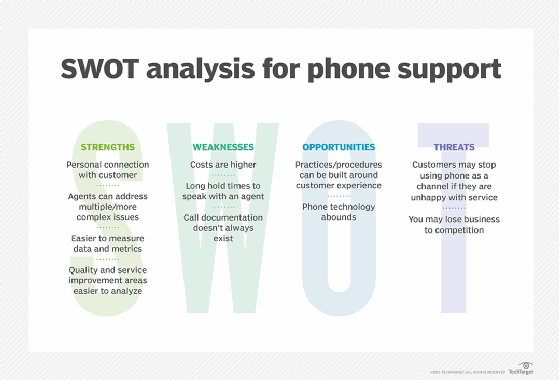
auremar - Fotolia
Compare pros and cons of live chat vs. phone support
Phone support offers personalized experiences, but live chat agents can answer simple inquiries more quickly. See how these service channels stack up against each other.
Across the contact center world, debate ensues over what customer support channels organizations should implement.
CX is the No. 1 competitive advantage in the war for customer loyalty, and transforming customer service channels can help organizations win that battle. Phone support has been the primary service channel for businesses since the 1960s, but live chat has seen increased adoption since the 2010s. Some people believe live chat may eventually surpass the phone as the top service channel. As the consumer landscape changes, this debate may continue.
Phone support and live chat each have their own strengths and weaknesses. For instance, phone support offers customers personalized, one-to-one interactions but can cost more than live chat. Live chat can eliminate wait time and reduce costs, but it lacks the personal touch of phone support. CX leaders should know the difference between these channels before they purchase contact center software to decide which channels and features they require.
What is phone support?
Phone support lets customers call a phone number to reach an organization's customer service department. Callers may ask questions about products, accounts or technical problems, and organizations train their service agents to quickly resolve these issues over the phone.
As a tool that facilitates business and conversation, the phone has long been the leading channel for B2B and B2C communication. In the digital era, though, it must compete with other channels, such as live chat and social media.
CX leaders should understand phone support's strengths and weaknesses to find out if it's the right channel for their organization.

Strengths
- Personal connection. Phone interactions capture the speaker's tone, inflection and emotion, which can enhance communication and foster personal connections between agents and customers.
- Handle difficult issues and questions. Agents can handle complex inquiries that require critical thinking skills more than live chat.
- Metrics and data. CX leaders can measure data and metrics more easily with phone calls because they offer one-to-one interactions. Live chat agents, on the other hand, juggle multiple chats simultaneously, which may require more advanced calculations to analyze.
- Quality and service improvement. The customer's voice and emotion provide a richer input into quality and service improvement analysis.
Weaknesses
- Cost. Agents on the phone only handle one customer at a time. This setup can increase costs and decrease overall productivity. A call can also cost up to two times as much as an electronic interaction.
- Time. Phone support often frustrates customers with long wait times and lengthy interactive voice response menus.
- Documentation. Some organizations may not record every customer conversation. Unless a contact center implements and routinely monitors quality practices, phone support can fail to document important conversations.
Opportunities
- Practices. Organizations can implement best practices, such as call handling procedures and customer service trainings, to prioritize CX.
- Omnichannel CX. Many contact center tools offer omnichannel support, which lets customers use their preferred channel to contact an organization. This approach can enhance phone support because it lets agents view a customer's interaction history across channels. When phone agents can see a customer's past email and live chat interactions, customers don't have to repeat themselves over the phone.
Threats
- Usage. If customers aren't happy with phone support and service, they may complain.
- Competition. If organizations don't provide high quality phone support, they may lose customers to competitors that do.
What is live chat?
Live chat support lets customers interact with a live agent or chatbot as they browse an organization's website or mobile application. Customers that use live chat may have questions about products, pricing or how to navigate the organization's website.
Live chat is a newer technology than phone support, but it has quickly risen through the ranks. The rise of instant messaging took off in the 1990s when AOL Inc., Yahoo and Microsoft all introduced their own messaging programs. These tools let users send each other instant messages that contained text, video and photos. That era also introduced chat speak to the social lexicon.
CX leaders should consider live chat's strengths and weaknesses to determine if it makes sense for their organization.

Strengths
- Accessibility. Organizations can use live chat to offer their customers 24/7 support for a lower cost than phone support.
- Agent productivity. Agents can handle more than one chat at a time, which increases their overall productivity.
- Automated responses and bots. Chatbot technology can scan customer messages for keywords and submit automatic responses.
- Cost. Live chat agents and chatbots can answer customer inquiries at a lower cost than human agents.
- Data analytics. Live chat lets agents chat with customers and helps organizations understand customer needs. Many live chat tools offer web analytics features and integrations that show organizations what customers purchase, what products they view, where they get stuck and more.
Weaknesses
- Burnout. Although live chat agents can serve multiple customers simultaneously, the increased volume of customers can cause stress and burnout. In many contact centers, agents handle chat in addition to emails and phone calls. Organizations should put procedures in place to properly balance and monitor the agent workload.
- Limitations. Legal, compliance and regulatory restrictions can sometimes prevent an agent from helping a customer, which frustrates both parties. Organizations should let customers know the types of questions that agents can handle through chat, and should document this information in a service-level agreement (SLA).
- Time. Customers expect live chat agents to respond quickly to their questions, and organizations should do their best to meet this expectation. However, because agents handle multiple chats simultaneously, customers may experience delayed responses.
- Complicated issues. Live chat agents may struggle to resolve complex customer issues. Service agents can typically handle complicated issues more effectively over the phone than over live chat.
Opportunities
- Phone integration. Organizations can integrate their phone systems into their chat tools. Many contact centers use click-to-call buttons within chats that alert agents when customers would like to switch to another channel.
- Sales. Live chat agents can reach out to their website's visitors, recommend products and schedule in-person appointments to facilitate sales and convert visitors into actual customers.
Threats
- Processes and procedures. Organizations must ensure they have proper processes and procedures in place to run live chat successfully, including scripts, documentation, workload balancing and relevant technology.
- Skills. Live chat agents require proper training and continued skill development, including writing, grammar, sentence structure and multitasking skills.
What are the key components of a customer access strategy?
Before you try to decide between live chat and phone support, consider the following customer access strategy questions:
- Is it a desired contact channel for all customer segments?
- What types of contacts will this channel handle?
- Can you offer alternatives? If yes, how? Is it a pop-up? Click-to-call?
- What services do you offer during key hours? What's in your SLA?
- How will these contacts be routed? How will that affect your ability to meet service-level objectives?
- Where should these contacts be routed? Which agents can handle them? Do you have documented routing procedures?
- Will agents need specialized skills?
- What information is needed to complete requests through different channels? What legal or regulatory requirements do you have?
- What key metrics will measure your success?
- What framework related to other departments and roles is needed to implement channels?
Key differences between live chat and phone support
Although live chat and phone support both let customers contact customer service agents, they differ in many ways. Those differences include the following:
- Personalization. Phone support offers more personalized interactions than live chat because all interactions are one-to-one and in real time, whereas live chat agents juggle multiple conversations simultaneously. Also, phone conversations reveal the speakers' tone and inflection, which can help create a personal connection between customers and agents.
- Cost. Live chat support typically costs organizations less than phone support because agents and chatbots can handle multiple customers simultaneously.
- Sales potential. Live chat agents can use proactive chat to initiate conversations with potential customers as they browse an organization's website. This approach lets live chat agents convert leads into new customers, whereas customers typically initiate phone support interactions.
How to choose between live chat vs. phone support
Ideally, organizations should offer both phone support and live chat. Phone support offers customers personalized CX and lets them more easily explain complex problems, whereas live chat gives customers quick answers to simple questions and guides them toward a purchase. When organizations pair these service channels together, customers can choose which one they prefer.
In rare cases, organizations may want only one service channel. Phone support can help organizations in the following situations:
- No website or app. Organizations without a web presence should use phone support until they have a website or mobile app. Without a web presence, organizations have no practical way to reach customers through live chat.
- High volumes of complex questions. Phones let customers and agents work through complicated problems more quickly than chat. Therefore, organizations that commonly deal with complex customer questions should offer phone support.
- Want more personalization. If an organization offers live chat, but its customers often complain about the service, they may want to switch to or add phone support. Many customers want the personal touch that phone support offers, regardless of their questions.
Live chat can help organizations in the following situations:
- Strong web presence. To better connect with customers, organizations should meet them where they already are. For example, most organizations with a strong web presence serve online customers each day. A live chat support option enables those customers to easily reach a support agent through the channel they already use.
- High volumes of simple questions. Organizations that receive more frequently asked or simple questions from customers may consider live chat. Chatbots and live chat agents can answer simple customer questions more quickly than phone support.
- Want to boost sales. Unlike phone support, live chat agents can initiate conversations with customers as they browse the organization's website. This approach can open the door for agents to make a sale.







